Jing Xiong
A1: Asynchronous Test-Time Scaling via Conformal Prediction
Sep 18, 2025Abstract:Large language models (LLMs) benefit from test-time scaling, but existing methods face significant challenges, including severe synchronization overhead, memory bottlenecks, and latency, especially during speculative decoding with long reasoning chains. We introduce A1 (Asynchronous Test-Time Scaling), a statistically guaranteed adaptive inference framework that addresses these challenges. A1 refines arithmetic intensity to identify synchronization as the dominant bottleneck, proposes an online calibration strategy to enable asynchronous inference, and designs a three-stage rejection sampling pipeline that supports both sequential and parallel scaling. Through experiments on the MATH, AMC23, AIME24, and AIME25 datasets, across various draft-target model families, we demonstrate that A1 achieves a remarkable 56.7x speedup in test-time scaling and a 4.14x improvement in throughput, all while maintaining accurate rejection-rate control, reducing latency and memory overhead, and no accuracy loss compared to using target model scaling alone. These results position A1 as an efficient and principled solution for scalable LLM inference. We have released the code at https://github.com/menik1126/asynchronous-test-time-scaling.
LongEmotion: Measuring Emotional Intelligence of Large Language Models in Long-Context Interaction
Sep 09, 2025Abstract:Large language models (LLMs) make significant progress in Emotional Intelligence (EI) and long-context understanding. However, existing benchmarks tend to overlook certain aspects of EI in long-context scenarios, especially under realistic, practical settings where interactions are lengthy, diverse, and often noisy. To move towards such realistic settings, we present LongEmotion, a benchmark specifically designed for long-context EI tasks. It covers a diverse set of tasks, including Emotion Classification, Emotion Detection, Emotion QA, Emotion Conversation, Emotion Summary, and Emotion Expression. On average, the input length for these tasks reaches 8,777 tokens, with long-form generation required for Emotion Expression. To enhance performance under realistic constraints, we incorporate Retrieval-Augmented Generation (RAG) and Collaborative Emotional Modeling (CoEM), and compare them with standard prompt-based methods. Unlike conventional approaches, our RAG method leverages both the conversation context and the large language model itself as retrieval sources, avoiding reliance on external knowledge bases. The CoEM method further improves performance by decomposing the task into five stages, integrating both retrieval augmentation and limited knowledge injection. Experimental results show that both RAG and CoEM consistently enhance EI-related performance across most long-context tasks, advancing LLMs toward more practical and real-world EI applications. Furthermore, we conducted a comparative case study experiment on the GPT series to demonstrate the differences among various models in terms of EI. Code is available on GitHub at https://github.com/LongEmotion/LongEmotion, and the project page can be found at https://longemotion.github.io/.
SAS: Simulated Attention Score
Jul 10, 2025Abstract:The attention mechanism is a core component of the Transformer architecture. Various methods have been developed to compute attention scores, including multi-head attention (MHA), multi-query attention, group-query attention and so on. We further analyze the MHA and observe that its performance improves as the number of attention heads increases, provided the hidden size per head remains sufficiently large. Therefore, increasing both the head count and hidden size per head with minimal parameter overhead can lead to significant performance gains at a low cost. Motivated by this insight, we introduce Simulated Attention Score (SAS), which maintains a compact model size while simulating a larger number of attention heads and hidden feature dimension per head. This is achieved by projecting a low-dimensional head representation into a higher-dimensional space, effectively increasing attention capacity without increasing parameter count. Beyond the head representations, we further extend the simulation approach to feature dimension of the key and query embeddings, enhancing expressiveness by mimicking the behavior of a larger model while preserving the original model size. To control the parameter cost, we also propose Parameter-Efficient Attention Aggregation (PEAA). Comprehensive experiments on a variety of datasets and tasks demonstrate the effectiveness of the proposed SAS method, achieving significant improvements over different attention variants.
Mathesis: Towards Formal Theorem Proving from Natural Languages
Jun 08, 2025



Abstract:Recent advances in large language models show strong promise for formal reasoning. However, most LLM-based theorem provers have long been constrained by the need for expert-written formal statements as inputs, limiting their applicability to real-world problems expressed in natural language. We tackle this gap with Mathesis, the first end-to-end theorem proving pipeline processing informal problem statements. It contributes Mathesis-Autoformalizer, the first autoformalizer using reinforcement learning to enhance the formalization ability of natural language problems, aided by our novel LeanScorer framework for nuanced formalization quality assessment. It also proposes a Mathesis-Prover, which generates formal proofs from the formalized statements. To evaluate the real-world applicability of end-to-end formal theorem proving, we introduce Gaokao-Formal, a benchmark of 488 complex problems from China's national college entrance exam. Our approach is carefully designed, with a thorough study of each component. Experiments demonstrate Mathesis's effectiveness, with the autoformalizer outperforming the best baseline by 22% in pass-rate on Gaokao-Formal. The full system surpasses other model combinations, achieving 64% accuracy on MiniF2F with pass@32 and a state-of-the-art 18% on Gaokao-Formal.
From Objects to Anywhere: A Holistic Benchmark for Multi-level Visual Grounding in 3D Scenes
Jun 05, 2025Abstract:3D visual grounding has made notable progress in localizing objects within complex 3D scenes. However, grounding referring expressions beyond objects in 3D scenes remains unexplored. In this paper, we introduce Anywhere3D-Bench, a holistic 3D visual grounding benchmark consisting of 2,632 referring expression-3D bounding box pairs spanning four different grounding levels: human-activity areas, unoccupied space beyond objects, objects in the scene, and fine-grained object parts. We assess a range of state-of-the-art 3D visual grounding methods alongside large language models (LLMs) and multimodal LLMs (MLLMs) on Anywhere3D-Bench. Experimental results reveal that space-level and part-level visual grounding pose the greatest challenges: space-level tasks require a more comprehensive spatial reasoning ability, for example, modeling distances and spatial relations within 3D space, while part-level tasks demand fine-grained perception of object composition. Even the best performance model, OpenAI o4-mini, achieves only 23.57% accuracy on space-level tasks and 33.94% on part-level tasks, significantly lower than its performance on area-level and object-level tasks. These findings underscore a critical gap in current models' capacity to understand and reason about 3D scene beyond object-level semantics.
SwingArena: Competitive Programming Arena for Long-context GitHub Issue Solving
May 29, 2025Abstract:We present SwingArena, a competitive evaluation framework for Large Language Models (LLMs) that closely mirrors real-world software development workflows. Unlike traditional static benchmarks, SwingArena models the collaborative process of software iteration by pairing LLMs as submitters, who generate patches, and reviewers, who create test cases and verify the patches through continuous integration (CI) pipelines. To support these interactive evaluations, we introduce a retrieval-augmented code generation (RACG) module that efficiently handles long-context challenges by providing syntactically and semantically relevant code snippets from large codebases, supporting multiple programming languages (C++, Python, Rust, and Go). This enables the framework to scale across diverse tasks and contexts while respecting token limitations. Our experiments, using over 400 high-quality real-world GitHub issues selected from a pool of 2,300 issues, show that models like GPT-4o excel at aggressive patch generation, whereas DeepSeek and Gemini prioritize correctness in CI validation. SwingArena presents a scalable and extensible methodology for evaluating LLMs in realistic, CI-driven software development settings. More details are available on our project page: swing-bench.github.io
PhyX: Does Your Model Have the "Wits" for Physical Reasoning?
May 21, 2025
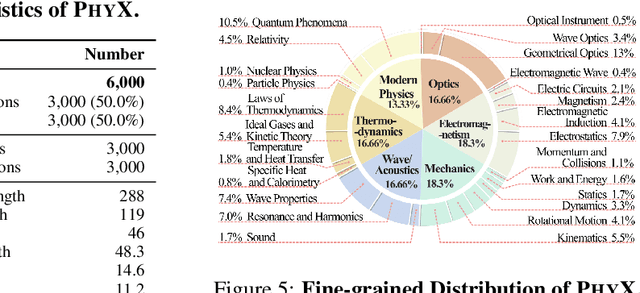
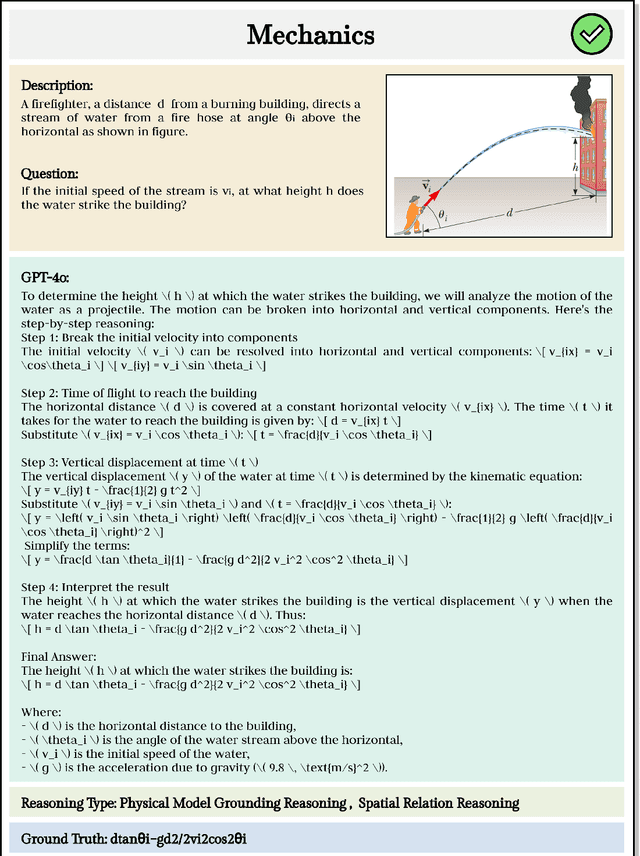
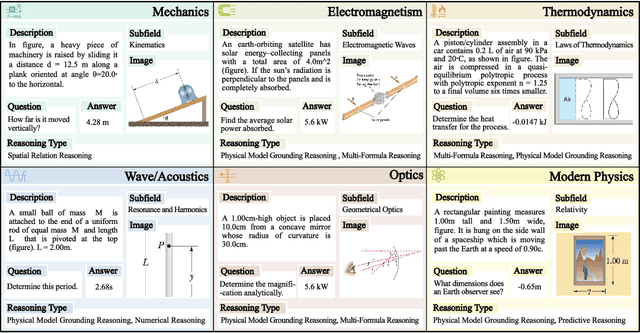
Abstract:Existing benchmarks fail to capture a crucial aspect of intelligence: physical reasoning, the integrated ability to combine domain knowledge, symbolic reasoning, and understanding of real-world constraints. To address this gap, we introduce PhyX: the first large-scale benchmark designed to assess models capacity for physics-grounded reasoning in visual scenarios. PhyX includes 3K meticulously curated multimodal questions spanning 6 reasoning types across 25 sub-domains and 6 core physics domains: thermodynamics, electromagnetism, mechanics, modern physics, optics, and wave\&acoustics. In our comprehensive evaluation, even state-of-the-art models struggle significantly with physical reasoning. GPT-4o, Claude3.7-Sonnet, and GPT-o4-mini achieve only 32.5\%, 42.2\%, and 45.8\% accuracy respectively-performance gaps exceeding 29\% compared to human experts. Our analysis exposes critical limitations in current models: over-reliance on memorized disciplinary knowledge, excessive dependence on mathematical formulations, and surface-level visual pattern matching rather than genuine physical understanding. We provide in-depth analysis through fine-grained statistics, detailed case studies, and multiple evaluation paradigms to thoroughly examine physical reasoning capabilities. To ensure reproducibility, we implement a compatible evaluation protocol based on widely-used toolkits such as VLMEvalKit, enabling one-click evaluation.
Self-Adjust Softmax
Feb 25, 2025Abstract:The softmax function is crucial in Transformer attention, which normalizes each row of the attention scores with summation to one, achieving superior performances over other alternative functions. However, the softmax function can face a gradient vanishing issue when some elements of the attention scores approach extreme values, such as probabilities close to one or zero. In this paper, we propose Self-Adjust Softmax (SA-Softmax) to address this issue by modifying $softmax(x)$ to $x \cdot softmax(x)$ and its normalized variant $\frac{(x - min(x_{\min},0))}{max(0,x_{max})-min(x_{min},0)} \cdot softmax(x)$. We theoretically show that SA-Softmax provides enhanced gradient properties compared to the vanilla softmax function. Moreover, SA-Softmax Attention can be seamlessly integrated into existing Transformer models to their attention mechanisms with minor adjustments. We conducted experiments to evaluate the empirical performance of Transformer models using SA-Softmax compared to the vanilla softmax function. These experiments, involving models with up to 2.7 billion parameters, are conducted across diverse datasets, language tasks, and positional encoding methods.
ParallelComp: Parallel Long-Context Compressor for Length Extrapolation
Feb 20, 2025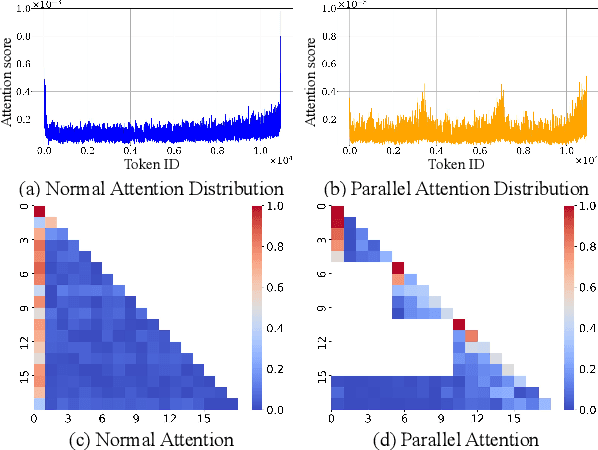
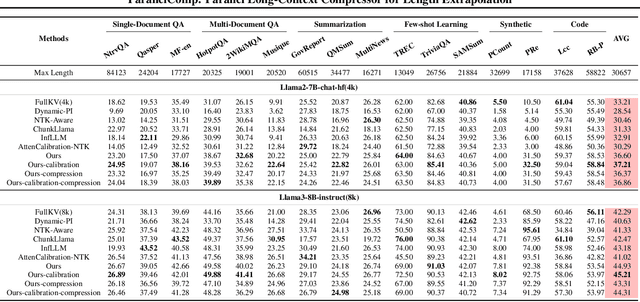

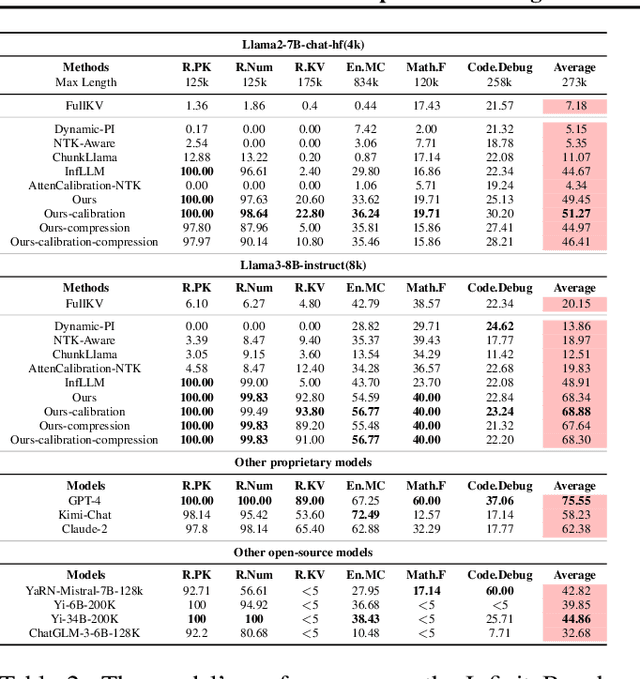
Abstract:Efficiently handling long contexts is crucial for large language models (LLMs). While rotary position embeddings (RoPEs) enhance length generalization, effective length extrapolation remains challenging and often requires costly fine-tuning. In contrast, recent training-free approaches suffer from the attention sink phenomenon, leading to severe performance degradation. In this paper, we introduce ParallelComp, a novel training-free method for long-context extrapolation that extends LLMs' context length from 4K to 128K while maintaining high throughput and preserving perplexity, and integrates seamlessly with Flash Attention. Our analysis offers new insights into attention biases in parallel attention mechanisms and provides practical solutions to tackle these challenges. To mitigate the attention sink issue, we propose an attention calibration strategy that reduces biases, ensuring more stable long-range attention. Additionally, we introduce a chunk eviction strategy to efficiently manage ultra-long contexts on a single A100 80GB GPU. To further enhance efficiency, we propose a parallel KV cache eviction technique, which improves chunk throughput by 1.76x, thereby achieving a 23.50x acceleration in the prefilling stage with negligible performance loss due to attention calibration. Furthermore, ParallelComp achieves 91.17% of GPT-4's performance on long-context tasks using an 8B model trained on 8K-length context, outperforming powerful closed-source models such as Claude-2 and Kimi-Chat.
Noise-Resilient Point-wise Anomaly Detection in Time Series Using Weak Segment Labels
Jan 21, 2025



Abstract:Detecting anomalies in temporal data has gained significant attention across various real-world applications, aiming to identify unusual events and mitigate potential hazards. In practice, situations often involve a mix of segment-level labels (detected abnormal events with segments of time points) and unlabeled data (undetected events), while the ideal algorithmic outcome should be point-level predictions. Therefore, the huge label information gap between training data and targets makes the task challenging. In this study, we formulate the above imperfect information as noisy labels and propose NRdetector, a noise-resilient framework that incorporates confidence-based sample selection, robust segment-level learning, and data-centric point-level detection for multivariate time series anomaly detection. Particularly, to bridge the information gap between noisy segment-level labels and missing point-level labels, we develop a novel loss function that can effectively mitigate the label noise and consider the temporal features. It encourages the smoothness of consecutive points and the separability of points from segments with different labels. Extensive experiments on real-world multivariate time series datasets with 11 different evaluation metrics demonstrate that NRdetector consistently achieves robust results across multiple real-world datasets, outperforming various baselines adapted to operate in our setting.
 Add to Chrome
Add to Chrome Add to Firefox
Add to Firefox Add to Edge
Add to Edge